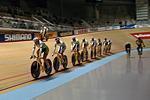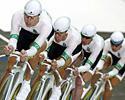
Recently on Cyclingnews.com |
Tech feature - June 21, 2004
BT to hit the road
Got tech? Send press releases, news, and tech questions to the Cyclingnews tech-heads.
The frames are instantly recognizable to followers of track racing - and even those who only check in during the world's or Olympics - due to that distinctive top-tube; a flowing, sweeping arc of carbon fibre that starts at the head-tube and stops right at the rear wheel track-ends. Gerard Knapp learns more about BT and its plans to offer its design in a road time trial configuration.

|
They are - arguably - the fastest production track frames available today. That may be overstating the case, as the performance of the athlete is paramount, but the stiffness and aerodynamic qualities of the rider, frame and wheels are the most important factors in the design of any human-powered speed machine, particularly on the track, where events are decided by a thousand of a second.
At the 2003 Track Cycling World Championships, a quartet of young Australian riders covered 4km in the (still) staggering time of 3.57.28 - an average speed of 60.687 km/h.
That world record was something of an Australian success story, as the riders were aboard bikes that came from a small factory in Melbourne, Australia. Known generically as 'BTs', the bikes are made by Bike Technologies Australia, a company that started in the mid-'90s.
According to Steve Sansonetti from BT - himself a Victorian state representative track cyclist and son of company founder Sal Sansonetti - the company's first major output was to produce bikes for the 1996 Australian Olympic team.
These machines were based on the 'Superbike' design that came from the Royal Melbourne Institute of Technology (RMIT). The 'Superbike' had a huge impact when it was launched but it had its wings clipped - at least for serious competition - when the UCI changed the rules relating to bicycle design following the Atlanta Games and 1996 Track Cycling world Championships. The Superbike was a single-piece, solid carbon fibre monocoque that delivered exceptional aerodynamic properties.
Instead, the UCI wanted bicycles to look like, well, bicycles, so it was back to the drawing board. The end result is a design by Sansonetti Sr. and Brian Hayes (of the Australian Institute of Sport) that has become the current BT shape.
While the shape has changed little over the years, BT continues to refine the design of the track frames.
Road time trial machine

|
Significantly, the next major project is a road time trial frame and the first customer will be Holland's Leontien Zijlaard - Van Moorsel, who plans to ride one in the road time trial at the 2004 Athens Olympics.
Sansonetti said Van Moorsel is one of BT's highest-profile customers, ever since she threw a leg over one of the machines while checking out Sydney's Dunc Gray Velodrome prior to the 2000 Olympics.
He said testing on the road TT machine has shown it could deliver considerable benefits in a longer events (compared to timed track events), such as a prologue or a full time trial.
"This one has tested so well compared to anything before," he said. "We're looking at a three to five percent improvement in aerodynamics and over say an 8km prologue, that could make a real difference."
It's expected - well, it's essential for Van Moorsel's plan to defend her Olympic road TT crown - that BT will finish the first road TT machine by the end of this month. BT is actually building two frames - one for still conditions, and another for when it's windy. He said the design is very similar to the track frame, except "it's a bit more relaxed and the rider is a bit further behind the bottom bracket".

|
However, BTs are available for not just superstars of the track, but any rider who really values his or her track cycling a great deal. They come in four basic sizes: 53, 55, 57 and 59cm. In BT sizing, this is the effective length of the top tube, as the size of the seat tube can be customized to fit the rider, as can the wheelbase. However, the 'standard' sizing is square, in that a 53cm top-tube bike will have an effective seat tube of 53cm. "But our bikes are generally not off-the-peg," said Sansonetti. "It depends on what the rider is using it for."
The dimensions vary slightly for sprinting and endurance, with the endurance frames sitting lower than the sprinters' machines. The sprint machines also have more carbon and a unidirectional lay-up structure, particularly around the bottom bracket, to withstand the brute force of the sprinters.
The frames are not the lightest on the market, but that's hardly an issue for trackies, said Sansonetti. The BTs are by no means heavy, as the frames weigh from 1.5 to 2.2kg, depending on the size and specification. Interestingly, he said that a bike that weighs 0.5kg more may result in a 10-15 watt difference in output (to achieve the same time over a given distance). However, aerodynamics is far more important, as Sansonetti said a poor aerodynamic design can result in a 200W difference.
The frames are currently used by the Australian and Dutch national teams, as well as South Korea, some of the Chinese and South African riders. In addition, Kiwi rider Greg Henderson rode a beautiful black-framed BT to take gold in the men's 15km scratch race at the Melbourne world's (in addition to the men's team pursuit, the men's sprint and women's 500mm TT).
The frames are directly available in Australia from BT in Melbourne (61 3 9459 3525) and in the USA, try www.usauzziesales.com. The price? In the USA, the official distributor lists the frame and fork at US$4395.
But as one sales person once said, "it's not how much the bike is worth, it's how important the cycling is to you".
Related story
Longevity rules in the Van Moorsel
shed
Big talent pool keeps Australian pursuiters keen for the team
Recent techTour tech: Zipp's slippery
new wheel revealed |

